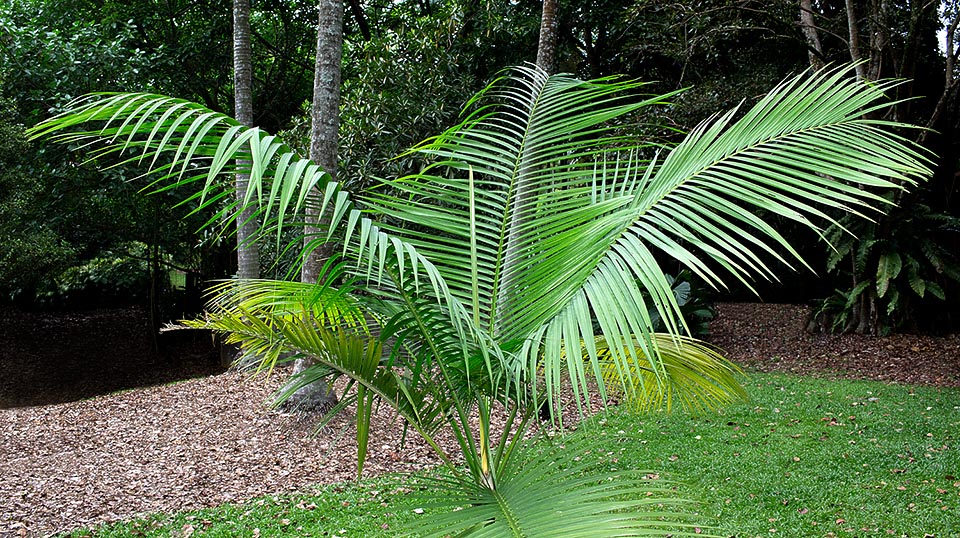Family : Arecaceae

Text © Pietro Puccio

English translation by Mario Beltramini

Rhopaloblaste elegans grows in the humid forests of Solomon Islands up to about 500 m of altitude © Giuseppe Mazza
The species is native to the Solomon Islands where it grows in the humid forests from the sea level up to about 500 m of altitude.
The name of the genus is the combination of the Greek substantives “ρόπαλον” (rhopalon) = club, bat and “βλαστός” (blastos) = embryo, with reference to its shape; the specific name is the Latin adjective “elegans, -antis” = elegant, with obvious reference.
Common names: elegant palm (English).
The Rhopaloblaste elegans H.E.Moore (1966) is an unarmed monoecious species with single erect stem, up to 12-14 m tall and of 8-10 cm of diameter, with enlarged base provided with adventitious roots, of dark grey colour on which are visible the rings trace of the junction of the fallen leaves.
The leaves, on a 5-8 cm long petiole, are pinnate, about 3,5 m long, with the foliar base, of pale green colour and densely covered by tiny brown-reddish scales, that wraps wholly the stem for a height of 60-80 cm forming a sort of tubular capital.
The leaflets, regularly arranged along the rachis in number of 70-76 per side, are linear with pointed and drooping apex, 64-68 cm long in the median part and 2,5-3,5 cm broad, of intense green colour above, paler below, with tiny brown scales on the central vein.
The inflorescences, on short peduncle and contained during the initial phase of growth in a deciduous bract of green colour, covered by brown tomentum, are ramified, 50-60 cm long, with greenish unisexual flowers arranged in groups of three (a female flower between two male flowers), but in the final part of the rachillae where are present only male flowers in pair or solitary.
Globose fruits, about 2,5 cm long, and of 2,3 cm of diameter, red purple when ripe, with mesocarp formed by flat longitudinal fibres, containing only one globose seed of 1,8-2 cm of diameter.
It reproduces by seed, previously cleaned from the pulp and kept in lukewarm water for 2 days, in aerated and draining loam maintained humid at the temperature of 26-28 °C, with germination times of about one month.
Specific name highly appropriate for this palm, unluckily still little diffused, cultivable exclusively in the humid tropical climate zones and marginally subtropical.
It requires high luminosity, also direct sun, but in the first years of growth when it needs a partial shade, and perfectly draining soils maintained constantly humid. Young plants are an excellent subject to cultivate in pot for the decoration of luminous inner spaces, with lowest values of temperature not under the 18 °C, utilizing a substratum rich of organic substance with addition of siliceous sand or agriperlite per a 30% maintained constantly humid, but without stagnations. Useful are the fertilizations, from spring to early autumn, with products specific for green pot plants.

Extremely decorative, can be 12-14 m tall in the tropics. Difficult to cultivate it elsewhere because does not stand temperatures under 18 °C and when growing needs sun © Giuseppe Mazza
→ For general notions about ARECACEAE please click here.
